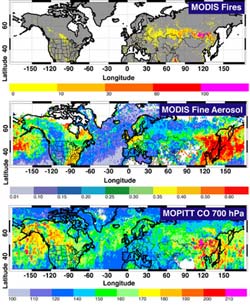NASA’s Terra Satellite Tracks Global Pollution

Pollution Outflow from Spring 2003 Fires in Siberia <br> <br>In the spring of 2003 there were large numbers of fires in Siberia, especially in the Baikal region. These were detected by the MODIS instrument on the Terra satellite (top). This graphic shows the number of fires detected during the month of May, 2003. These fires produced large amounts of fine carbon aerosol which spread out over the Pacific Ocean (center). The suspended particles, also detected by MODIS, only last for a few days. The MOPITT instrument on the Terra satellite measures carbon monoxide gas (CO). CO was also produced by the fires (bottom). This pollutant can last for over a month. The longer lifetime allows the gas to cross the Pacific Ocean and reduce air quality over North America before continuing on around the globe. Credit: David Edwards, NCAR <br>
Data from NASA’s Terra satellite is adding to our understanding of how pollution spreads around the globe. The information will help scientists protect and understand the Earth.
NASA funded scientists from the National Center for Atmospheric Research (NCAR), Boulder, Colo., will present two studies focusing on global air pollution. Their presentations are part of the 2004 Joint Assembly of the American and Canadian Geophysical Unions.
David Edwards will discuss “Observations of Carbon Monoxide and Aerosol from the Terra Satellite: Northern Hemisphere Variability,” on Thursday at 8:45 a.m. EDT in room 520D of the Palais des Congrès, Montreal. Cathy Clerbaux will discuss, “Tracking of Pollution Plumes Using Measurements of Pollution in the Troposphere (MOPITT) Measurements,” at 9:30 a.m. EDT.
Both studies used instruments on NASA’s Terra satellite to examine trends in global carbon monoxide (CO) and fine particulate (aerosol) pollution. Industry and vehicles in urban regions and fires produce these pollutants.
Terra and other NASA Earth observing satellites provide vital tools for monitoring global levels, sources and destinations of CO and other pollutants. The growing data record shows seasonal and annual variations, clues about how our planet may be changing. CO molecules can last from a few weeks to several months in the atmosphere, allowing them to travel long distances and impact air quality far from the point of emission.
Edwards, an NCAR researcher, used two sensors on NASA’s Terra to track CO and aerosols from smoke originating in Russia. The plumes were tracked as they spread across the Pacific Ocean, filling the Northern Hemisphere.
In late summer 2002 and spring 2003, Terra observed big fires in western Russia and Siberia. The fires led to a ’dirty’ 2002/03 winter atmosphere in the Northern Hemisphere with high amounts of CO and aerosol. Peak levels of CO hung over the United States.
By using two complementary instruments on Terra, Edwards was able to tell the difference between pollutants originating from wildfires and those from urban and industrial sources. The MOPITT instrument provided CO data, while the Moderate-resolution Imaging Spectroradiometer (MODIS) instrument recorded aerosol data.
“The satellite observations showed Russian fires have a huge impact on air quality on a global scale,” Edwards said. “This work helps get the message across, that when it comes to pollution, we need to think globally,” he added.
Work has started to see if the MOPITT instrument can track CO pollution originating from cities. Clerbaux, a scientist visiting NCAR from the French National Center for Scientific Research, points out tracking pollution from cities is very important, since half the people on Earth will live in urban centers by 2007.
Though MOPITT was not designed specifically to detect pollution plumes from cities, the results look promising. By selecting the data and averaging it over long time periods, the observations were made more reliable, and help distinguish the city emissions from other distant sources.
MOPITT data shows how wildfires in Kalimantan on Borneo Island in Indonesia, contaminated the air in 2002 above Jakarta, Indonesia. “The instrument also shows how pollution gets dispersed from cities,” Clerbaux said. “Mexico City and Jakarta are both surrounded by mountains. Due to topography, Terra revealed pollution could only escape upward or through openings in the landscape. For example, like the area to the north for Mexico City,” she added.
NASA’s Earth Science Enterprise is dedicated to understanding the Earth as an integrated system and applying Earth System Science to improve prediction of climate, weather, and natural hazards using the unique vantage point of space.
Media Contact
More Information:
http://www.gsfc.nasa.gov/topstory/2004/0517mopitt.htmlAll latest news from the category: Ecology, The Environment and Conservation
This complex theme deals primarily with interactions between organisms and the environmental factors that impact them, but to a greater extent between individual inanimate environmental factors.
innovations-report offers informative reports and articles on topics such as climate protection, landscape conservation, ecological systems, wildlife and nature parks and ecosystem efficiency and balance.
Newest articles

Recovering phosphorus from sewage sludge ash
Chemical and heat treatment of sewage sludge can recover phosphorus in a process that could help address the problem of diminishing supplies of phosphorus ores. Valuable supplies of phosphorus could…

Efficient, sustainable and cost-effective hybrid energy storage system for modern power grids
EU project HyFlow: Over three years of research, the consortium of the EU project HyFlow has successfully developed a highly efficient, sustainable, and cost-effective hybrid energy storage system (HESS) that…

After 25 years, researchers uncover genetic cause of rare neurological disease
Some families call it a trial of faith. Others just call it a curse. The progressive neurological disease known as spinocerebellar ataxia 4 (SCA4) is a rare condition, but its…





















